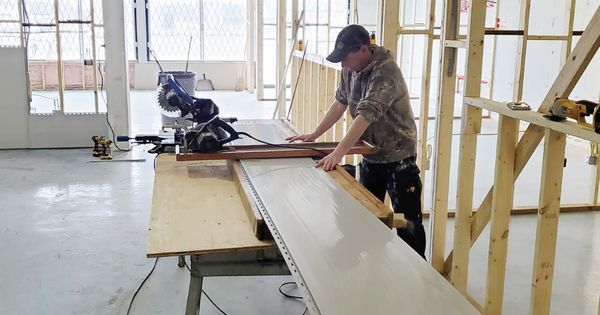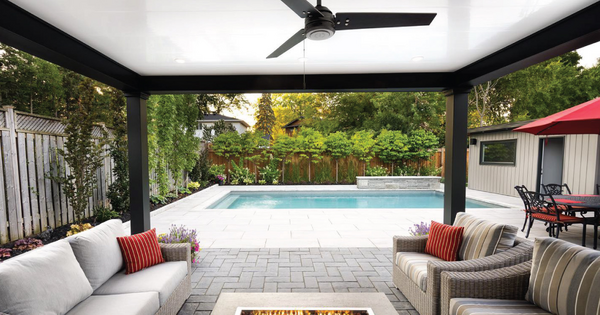In the ever-evolving realm of housing alternatives, modular and manufactured homes are gaining popularity as practical alternatives to traditional, site-built houses.
But what sets these homes apart? And what’s the difference between the two turns? Let's cut through the jargon and delve into the nuances of modular versus manufactured homes, highlighting the practical aspects that matter.

What are Manufactured and Modular Homes?
Manufactured homes and modular homes might sound like interchangeable terms, but they're not.
A manufactured home, formerly known as a mobile home, is entirely built in a factory, and is transported to its final location. In contrast, modular homes are constructed in sections or modules off-site and then assembled on-site. The key differences lie in their construction methods, building codes, and customization options.
Construction Methods of Modular vs. Manufactured Homes
Manufactured and modular homes are both prefabricated, meaning they’re partially or entirely built off-site in a factory setting. However, the construction methods for these two types of homes differ in several key aspects. First, modular homes:
- Local Building Codes. Modular homes are constructed to comply with local building codes and standards, just like traditional site-built homes. They aren’t subject to the same federal Housing and Urban Development (HUD) Code as manufactured homes.
- Transportation to Site. After factory construction, modules are transported to the installation site. Transportation can involve flatbed trucks or other methods, depending on the size and design of the modules.
- Customization. Modular homes often offer greater customization options compared to manufactured homes. Homebuyers may have more flexibility in choosing floor plans, finishes, and other design elements.
- Permanent Foundation. Modular homes are typically placed on a permanent foundation, such as a concrete slab or crawl space, but the foundation type can vary based on local building codes and site conditions.
- On-Site Assembly. Once on-site, the modules are assembled and connected to create a cohesive and fully integrated home. This on-site assembly process requires coordination and skilled labor.
And in comparison, here are some of the construction methods and considerations for manufactured homes:
- Steel Chassis. Manufactured homes are built on a steel chassis, which serves as a structural foundation and facilitates transportation to the installation site.
- Axles and Wheels. Manufactured homes are often equipped with axles and wheels for transportation to the installation site. Once on-site, these can be removed or concealed.
- HUD Code Compliance. Manufactured homes are constructed in accordance with the U.S. Department of Housing and Urban Development (HUD) Code. This federal code sets standards for design, construction, transportation, and installation.
- Limited Customization. Manufactured homes often have limited customization options compared to modular or site-built homes due to the constraints of the factory assembly line and adherence to the HUD Code. More on that later.
- Pier-and-Beam Foundation. Manufactured homes are typically installed on a pier-and-beam foundation or concrete block foundation. The steel chassis remains a structural element even after installation.
Design and Customization Options for Modular vs. Manufactured Homes
The design and customization options for modular and manufactured homes can vary based on factors such as the construction method, building codes, and the capabilities of the manufacturer.
Modular homes offer a higher degree of customization, allowing homeowners to craft a living space that aligns with their unique preferences and requirements:
- Extensive Customization. Buyers can often work with modular home manufacturers to customize floor plans, layouts, and architectural styles.
- Architectural Styles. Modular homes can be designed to resemble traditional site-built homes and can be customized to fit various architectural styles, including colonial, contemporary, craftsman, and more.
- Materials and Finishes. Modular homebuyers have a broader range of choices for interior and exterior finishes, including flooring, countertops, cabinetry, siding, roofing materials, and more.
- Size and Layout Options. Modular homes come in a variety of sizes and layouts. Buyers can choose from single-story or multi-story configurations, and modules can be combined in different ways to create unique floor plans.
- Green Building Options. Some modular home manufacturers offer green building options, allowing buyers to incorporate environmentally friendly features, energy-efficient systems, and sustainable materials into their homes.
- Structural Flexibility. Modular homes allow for more structural flexibility, and homeowners may have the ability to make changes or additions to the floor plan within certain limits.
On the flip side, there are limited design and customization options available for manufactured homes, but homeowners do still have some say in what their home will look like:
- Floor Plans. Manufactured homes often offer a variety of floor plans to accommodate different preferences and lifestyles. Buyers can choose from single-section or multi-section homes with various layouts.
- Sizes and Styles. While there are standard sizes and styles of manufactured homes, some manufacturers may offer options for customization in terms of size, exterior finishes, and architectural styles.
- Finishes and Features. Buyers can often choose from a range of interior finishes, including flooring, countertops, cabinetry, and fixtures. Exterior finishes such as siding, roofing materials, and window styles also can be customized. However, the level of customization available is more limited compared to modular or site-built homes because the unit has to meet HUD Code requirements.
- Limited Structural Changes. Due to the nature of the manufacturing process and the need to comply with the HUD Code, significant structural changes or additions may be limited in manufactured homes.
It's important to note that the specific design and customization options available for both manufactured and modular homes can vary by manufacturer. Additionally, local building codes and zoning regulations may impose certain constraints on customization. Before making decisions, modular and manufactured homebuyers should work closely with the manufacturer to understand the available options and ensure compliance with all relevant codes and standards.

Building Codes and Regulations for Modular vs. Manufactured Homes
Building codes for modular and manufactured homes can vary since these homes have different construction and installation methods. It's important to note that building codes can also vary by location, as they are often set by local authorities.
Here are some general differences between building codes for modular and manufactured homes:
- Construction Standards. Modular homes are typically built to the same local building codes and standards as traditional site-built homes. They’re constructed in sections or modules in a factory and then transported to the site for assembly, and the construction process and materials used are like those of traditional homes. Manufactured homes are built to a federal code (HUD Code), which sets specific standards for design, construction, and installation. Manufactured homes are generally built on a steel chassis and transported to the site.
- Foundation Requirements. Modular homes are often placed on permanent foundations, such as a concrete slab or crawl space, similar to traditional homes. Manufactured homes are commonly placed on pier-and-beam foundations or concrete block foundations. They’re designed to be easily transported, and the chassis remains a structural component.
- Inspections. Modular homes undergo inspections during the factory construction process and are also subject to on-site inspections to ensure compliance with local building codes. Manufactured homes are subject to inspections in the factory during construction, but they also undergo a final inspection on-site to ensure compliance with the HUD Code.
- Appraisal and Financing. Modular homes are generally appraised and financed in the same way as traditional site-built homes. Financing and appraisal for manufactured homes may be subject to different criteria due to the unique characteristics of these homes. Some lenders may have specific requirements for financing manufactured homes.
- Zoning Restrictions. In many places, modular homes are subject to the same zoning regulations as traditional homes. Zoning regulations for manufactured homes can be more restrictive, with designated areas or parks specifically zoned for manufactured housing.
Pros and Cons of Modular vs. Manufactured Homes
Let's break it down into a detailed list of pros and cons. Whether it's the cost-effectiveness of manufactured homes or the design freedom offered by modular homes, understanding the advantages and disadvantages is crucial.



| Pros | Cons | ||
|---|---|---|---|
| Design Flexibility. Modular homes offer a higher degree of design flexibility and customization compared to manufactured homes. Buyers can often work with manufacturers to create unique floor plans and choose various finishes. | Cost. While generally more affordable than traditional site-built homes, modular homes may still have a higher upfront cost compared to manufactured homes. | ||
| Quality Control. The construction process in a controlled factory environment allows for consistent quality control and precision in building components. | Construction Time. Although faster than traditional construction, the construction time for modular homes may be longer than for manufactured homes due to customization and on-site assembly. | ||
| Local Building Codes. Modular homes are built to comply with local building codes and standards, similar to site-built homes, providing assurance of meeting local regulations. | Transportation Challenges. Transportation of modular home components to the site can be logistically challenging, especially for large or complex designs. | ||
| Permanent Foundation. Modular homes are typically placed on permanent foundations, contributing to a more traditional look and feel. This can positively impact resale value and acceptance in certain communities. | Permanent Foundation. Modular homes are typically placed on permanent foundations, contributing to a more traditional look and feel. This can positively impact resale value and acceptance in certain communities. | ||
| Energy Efficiency. Some modular homes can be designed with energy-efficient features and green building options, contributing to lower utility costs. |



| Pros | Cons | ||
|---|---|---|---|
| Affordability. Manufactured homes are often more affordable than modular or site built homes, making them an attractive option for budget-conscious buyers. | Limited Customization. As previously mentioned, customization options may be more limited compared to modular or site- built homes due to the constraints of the manufacturing process and HUD Code compliance. | ||
| Quick Construction. The construction process in a factory setting allows for quicker completion compared to traditional on-site construction. | Perception and Resale Value. Manufactured homes may face challenges in terms of perception and resale value, with some potential buyers having reservations about the quality or long-term value. | ||
| HUD Code Compliance. Manufactured homes comply with HUD Code, providing a federal standard for quality and safety. | Zoning Restrictions. Zoning restrictions may limit where manufactured homes can be placed, with some areas designated exclusively for site-built homes. | ||
| Transportability. The ability to transport a manufactured home to the installation site offers flexibility, especially for those who may need to relocate. | |||
| Variety of Floor Plans. There are a variety of floor plans available, offering different layouts to suit various preferences. |






